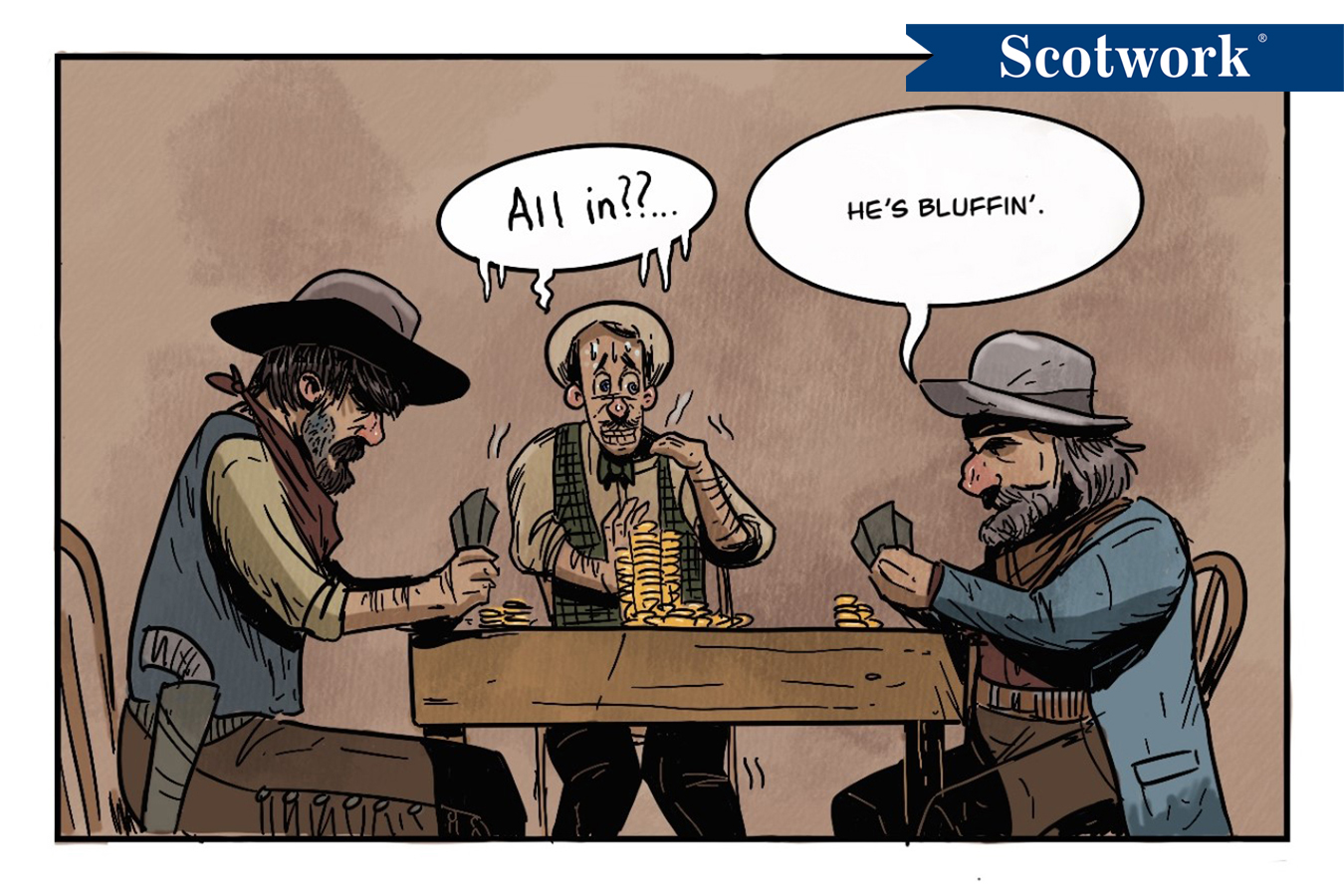“The whole place stops when Johnny Chan walks in.”
If you play poker or like Matt Damon movies, you probably recognize that line from the film Rounders. It comes from a story that Mike McDermott (Damon’s character) tells Joey Knish about when McDermott played against real-life World Series of Poker champion Johnny Chan. The gist of the story is that McDermott was intent on proving to himself that he could play with the best in the world. He attempted to bluff Chan with nothing but “rags” (i.e., he had no cards that would beat even the lowest paired hand). As it turned out, he held his ground and bluffed his way to winning that hand.
Do you think you could survive a bluff at the negotiating table?
Bluffing at the negotiating table happens all the time. Bluffs range from little exaggerations (like slightly reducing or increasing the time on a deadline) to flat-out lies (like telling someone you have another vendor who’s offering you a far lower price when you don’t even have another vendor to speak of).
I’m not here to pass judgment on whether you should or shouldn’t bluff — that’s up to you. It’s an ethical matter that can and should, be debated. Regardless of your position, just know that skilled negotiators know how to defend against bluffing (and, by extension, use bluffing to their advantage, regardless of whether they do so or not). For this post, I’m going to discuss only how to reduce your chances of being taken advantage of by characters like Mike McDermott.
First, let’s recognize that there’s an element of risk to bluffing. If your bluff is called, you could lose credibility, damage your reputation, or derail the negotiation to the point of deadlock. Even at the poker table, when we discover that someone’s bluffing, we feel cheated, and our defenses go up. In business, the consequences are usually more severe than a feeling of being cheated.
Secondly, bluffing is done in order to augment or disrupt the power balance of a negotiation. Usually, the party with more power doesn’t have to rely on bluffing to get its way. That’s not to say that they won’t bluff; it simply means that when you have the majority of power, there are other, less risky methods at your disposal.
Now, the real question becomes, “How do you recognize a bluff?” I’m sure we can go down a rabbit hole about micro-expressions and other physical tells, but the signs are actually easier to read than you might think.
Bluffs usually occur around statements of time, money, or decision criteria. They’re typically quantifiable. However, they’re almost always based on something that only one party knows about. This is the critical characteristic of a bluff. After all, if everyone had insight into the data point, then it’s an inane or very weak bluff!
When someone presents you with information that only they would know, it’s up to you to consider if the information is real or you’re being bluffed. The best way to do that is by curiosity and inspection.
Let’s say someone tells you, “We need your price to be 20% lower” or “We can’t give you more than a 5% discount.” These statements are designed to anchor the conversation and manage your expectations. They may be entirely accurate, but any skilled negotiator will want to verify the validity of the statements. That begins with asking questions like these:
- Why? Ask them why that’s their position. You want to understand the logic behind the statement. Is it a policy issue, a precedent issue, or just what they say as their opening position?
- What’s the basis of that? Ask them how they came to that position as you seek to understand the justification for it. Is there data that supports it? Is there an analysis that defends it? Or is it just a platitude used to throw you off?
- Under what circumstances could it change? Ask this question to determine if there’s any flexibility in their position. If there is, then the statement isn’t as firm as they want you to believe.
Skilled negotiators want to know the answers to these questions. They’re not only listening to the context of those answers but also how the questions are addressed. If the context isn’t reasonable, then the other side might be bluffing. If the answer is nebulous, or unclear, or they seem to be grasping for a response, that’s also a clue that they might be bluffing.
Before folding your hand or giving in, ask a few questions and verify their position. Armed with information, you can then decide if you’re going to fold like Johnny Chan or call their bluff (or be like Mike McDermott and cash in). It’s really up to you, but one thing is certain: We all want to be able to say, “I sat with the best in the world . . . and I won.”
We Can Help You Avoid Getting Bluffed at the Negotiating Table.
Are you getting bluffed at the negotiating table? It happens all the time when someone presents information to you that only they would know. The question is, how do you detect and defend against it? We can help! Drawing on nearly 50 years of real-world negotiating experience, we’ll assist you with getting better deals, saving time, and creating value for all involved — not to mention preserving and even strengthening relationships. Let us partner you with one of our advisers, ensuring that you’ve got the broadest view of your deal.

